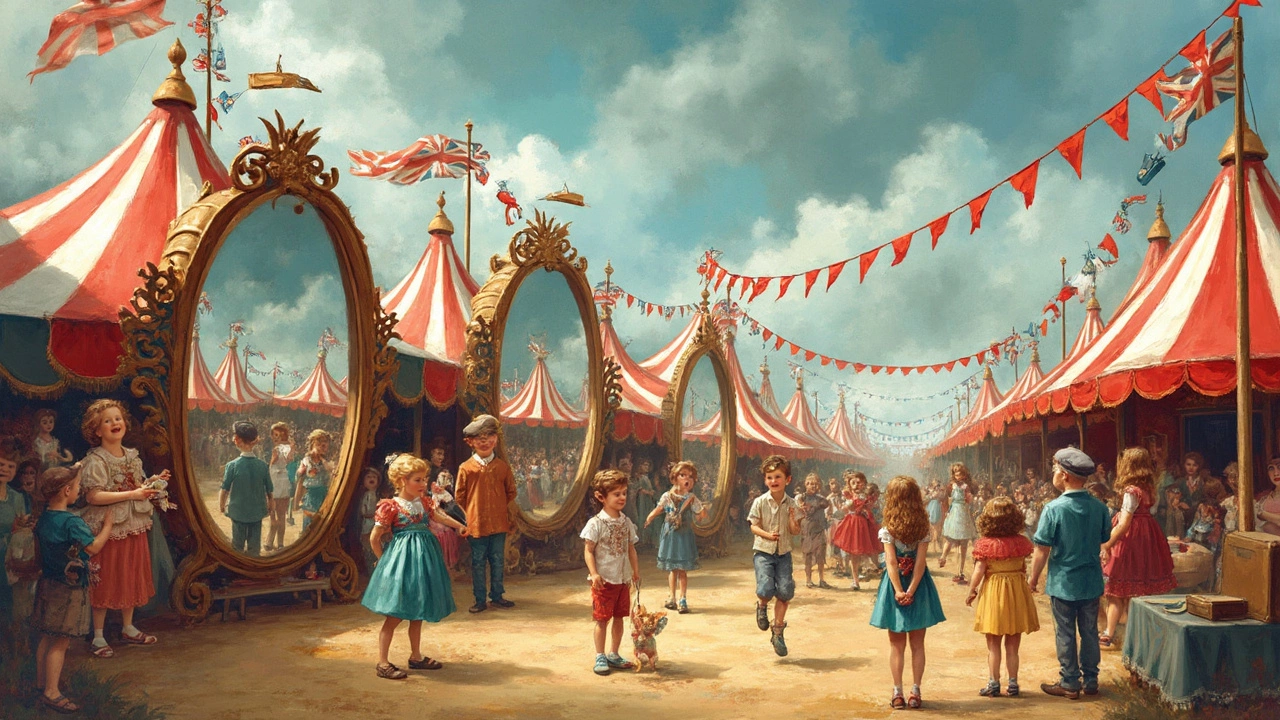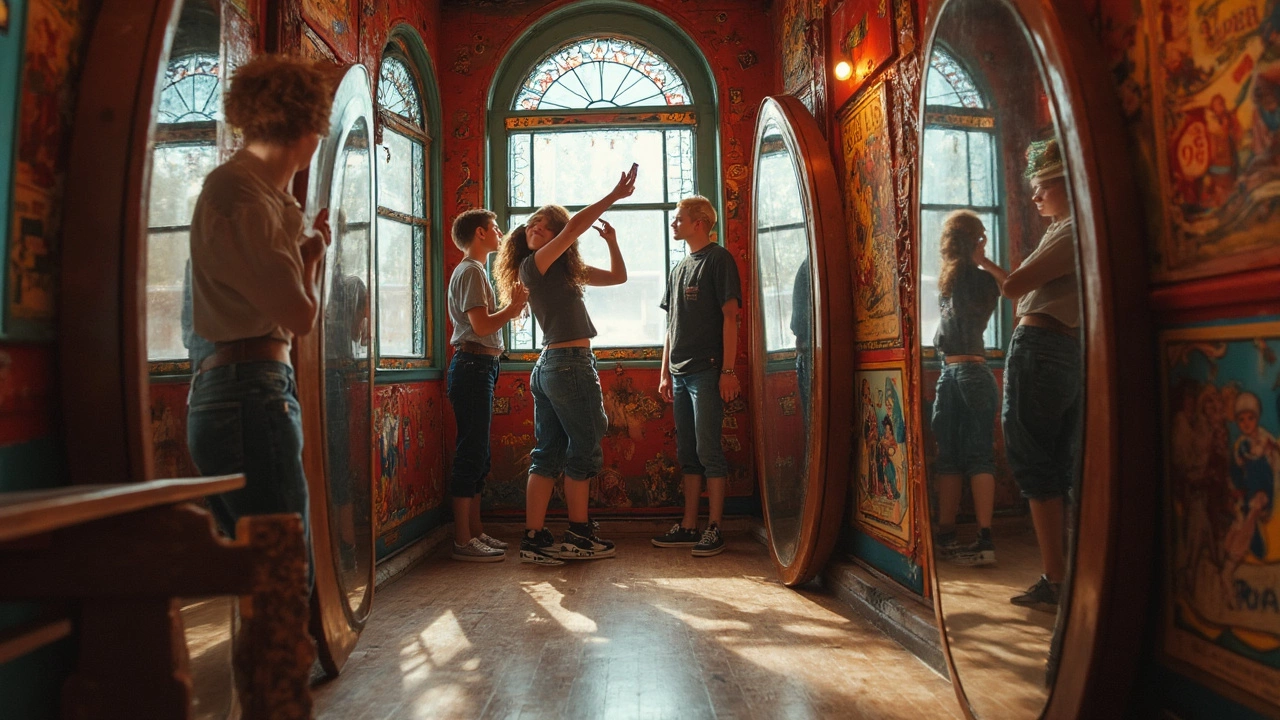Wacky Mirrors: What Are Those Funny Mirrors Called?

You know those mirrors that make you look like a squiggly noodle or taller than a basketball player? People usually call them funhouse mirrors or trick mirrors, but the technical name is actually distorting mirrors. These are built to bend and twist what you see, turning your reflection into something wild. They’ve been making people laugh at carnivals, fairs, and amusement parks for over a hundred years.
Getting the hang of how these mirrors work can be surprisingly useful. They use curved shapes—either bending out or in—to stretch, shrink, or twist your reflection in all sorts of funny ways. There’s no fancy electronics involved. Just clever designs with glass and metal. If you spot one, you’ll notice how they can turn a group selfie into a total disaster—in the best way possible.
- The Real Name for Wacky Mirrors
- How Funhouse Mirrors Work
- Where to Find and Use Wacky Mirrors
- DIY Tips and Fun Facts
The Real Name for Wacky Mirrors
Everyone calls them wacky, funhouse, or carnival mirrors, but the actual name for these jokesters is distorting mirrors. That’s what manufacturers, museums, and anyone working behind the scenes call them. The trick is in the shape: instead of being totally flat like your bathroom mirror, these have curves that warp anything reflected in them. These curves can go inward (concave), outward (convex), or a mix, which is why your head might look tiny while your feet look huge.
Funhouse mirrors first hit the scene in the early 1900s. Back then, they were a star attraction at Coney Island and arcades across the U.S. The idea was simple: make people laugh by messing with their reflections. It’s a classic, and you’ll still find them in traveling carnivals and some shopping malls today.
Here’s a quick cheat sheet of what folks call them, and where you might spot each name:
- Funhouse mirrors – Most used at amusement parks or fairs
- Distorting mirrors – The more technical term, seen in science museums
- Carnival mirrors – Popular at pop-up carnivals and festivals
- Trick mirrors – Sometimes used in older arcade or sideshow ads
And in case you’re curious about which shape does what, check out this table:
| Mirror Shape | Effect on Reflection |
|---|---|
| Concave | Makes things look bigger/stretched |
| Convex | Makes things look smaller or squished |
| Wavy (Mixed curves) | Creates distortion all over (twists, bends) |
So, next time you hear someone ask about those crazy mirrors, you can tell them: it’s a distorting mirror, and it’s the reason everyone looks like a comic book character for a few minutes.
How Funhouse Mirrors Work
The secret behind funhouse mirrors is all about the shape. They don't use magic or high-tech gadgets. Instead, the mirrors are bent in weird ways—curved in or out, or even twisted. This messes with how light bounces off them and changes what you see. Regular mirrors are flat, so they show your reflection how it really looks (for better or worse). With these, it's a whole different story.
There are two main types of curves in these mirrors:
- Convex mirrors bulge out and make your reflection look short and wide. Picture those silly mirrors where your head looks huge, but your legs are tiny.
- Concave mirrors dip in, making you look super tall and skinny or shrink parts of you down, depending on where you stand.
Sometimes, mirror makers mix these curves to give you an even crazier effect—think wavy lines that stretch some body parts while scrunching others.
Here’s what happens light-wise: light beams hit the bent mirror and bounce off at different angles. Your eyes see the wonky reflection, and your brain just goes with it. No matter what shape you are, you can step through a carnival mirror maze and come out looking completely different every time you turn a corner.
These mirrors aren’t just for laughs. The same bending tricks are used in security mirrors at stores and even in big science telescopes. But for laughs, nothing beats them at a fair or arcade.
| Mirror Shape | How You Look |
|---|---|
| Convex (bulges out) | Short & wide |
| Concave (dips in) | Tall & skinny |
| Wavy | Stretched or wobbly in random spots |
The most important thing to remember about funhouse mirrors? It’s all just clever curves messing with your mind—and giving you a good laugh in the process.

Where to Find and Use Wacky Mirrors
If you’re searching for a real-life laugh, you’ll usually find funhouse mirrors at amusement parks, carnivals, and traveling fairs. Old-school amusement parks, like Coney Island in New York or Blackpool Pleasure Beach in the UK, have had these classic mirrors for decades. You’ll spot them lining funhouses, sometimes in mirrored mazes that make just walking a challenge. They aren’t just for giggles though—science museums have stepped in, using wacky mirrors to show off optical illusions and how reflections work. Places like the Exploratorium in San Francisco feature these mirrors for kids and adults to play with shapes and light.
Shopping malls sometimes use smaller versions near play areas, while schools might roll them out for science fairs. There are even specialty mirror shops online where you can buy one to prank your houseguests or jazz up a game room. They're a popular photo booth prop at birthday parties and weddings—just picture everyone posing with stretched-out faces and gigantic heads.
For more practical or creative uses, set up a wacky mirror in a waiting room to break the ice or at a gym for a bit of motivation (or comic relief) near the treadmills. Some theater groups use them in stage sets for surreal scenes or special effects. If you’re into DIY, lightweight acrylic versions make it easy to move them into different rooms whenever you want to shake things up a bit. The bottom line: wherever people want to laugh or see something out of the ordinary, you’ll probably find one of these mirrors nearby.
DIY Tips and Fun Facts
Want your own set of wacky mirrors at home? It's actually easier than you might think. These mirrors don’t need any high-tech gear—just a little creativity, some patience, and a trip to the hardware store. Here's how you can pull off your own version for a party, kids’ playroom, or even a backyard carnival.
- Funhouse mirrors work best with flexible acrylic or plastic mirrors instead of glass. They're safer to handle and easier to bend without shattering.
- Mount the plastic mirror panel to a curved frame. The more you curve it (either outward or inward), the more your reflection gets distorted.
- Don’t worry about fancy tools. Many people use things like bent wooden boards, pool noodles, or even hula hoops as frames. Zip ties or strong glue help secure the mirror to the frame.
- If you want more than one shape, make several frames with different curves—one can make you look tall, another super wide, another all zigzagged.
Just a heads up—acrylic mirrors also scratch more easily than glass, so keep them clean with a soft cloth.
These mirrors aren’t just for laughs. They’ve actually played a real part in science and history. In 1676, English scientist Robert Hooke used one to look at microscopic things from another angle. Even high school science labs use curved mirrors to teach about light and optics.
Check out these quick facts and stats about these wild mirrors:
| Fact | Details |
|---|---|
| Oldest Known Use | Hall of Mirrors, 19th century fairs in Europe |
| Most Popular Material | Flexible acrylic mirror, used in 90%+ of modern designs |
| Real-Life Record | World’s largest funhouse mirror maze opened in 2009 in Gatlinburg, Tennessee |
| Schools Using Mirrors for Science Lessons | Over 2,500 U.S. schools reported in a 2023 survey |
If you set one up at home, keep it somewhere with good lighting—that really helps pull off the weirdest reflections. Also, a mirror like this makes for awesome party pics and TikTok moments, so don't be surprised if your friends can't resist taking a hundred selfies in front of it!